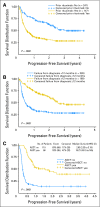Salvage regimens with autologous transplantation for relapsed large B-cell lymphoma in the rituximab era
- PMID: 20660832
- PMCID: PMC3664033
- DOI: 10.1200/JCO.2010.28.1618
Salvage regimens with autologous transplantation for relapsed large B-cell lymphoma in the rituximab era
Erratum in
- J Clin Oncol. 2012 May 20;30(15):1896
Abstract
Purpose: Salvage chemotherapy followed by high-dose therapy and autologous stem-cell transplantation (ASCT) is the standard treatment for relapsed diffuse large B-cell lymphoma (DLBCL). Salvage regimens have never been compared; their efficacy in the rituximab era is unknown.
Patients and methods: Patients with CD20(+) DLBCL in first relapse or who were refractory after first-line therapy were randomly assigned to either rituximab, ifosfamide, etoposide, and carboplatin (R-ICE) or rituximab, dexamethasone, high-dose cytarabine, and cisplatin (R-DHAP). Responding patients received high-dose chemotherapy and ASCT.
Results: The median age of the 396 patients enrolled (R-ICE, n = 202; R-DHAP, n = 194) was 55 years. Similar response rates were observed after three cycles of R-ICE (63.5%; 95% CI, 56% to 70%) and R-DHAP (62.8%; 95 CI, 55% to 69%). Factors affecting response rates (P < .001) were refractory disease/relapse less than versus more than 12 months after diagnosis (46% v 88%, respectively), International Prognostic Index (IPI) of more than 1 versus 0 to 1 (52% v 71%, respectively), and prior rituximab treatment versus no prior rituximab (51% v 83%, respectively). There was no significant difference between R-ICE and R-DHAP for 3-year event-free survival (EFS) or overall survival. Three-year EFS was affected by prior rituximab treatment versus no rituximab (21% v 47%, respectively), relapse less than versus more than 12 months after diagnosis (20% v 45%, respectively), and IPI of 2 to 3 versus 0 to 1 (18% v 40%, respectively). In the Cox model, these parameters were significant (P < .001).
Conclusion: In patients who experience relapse more than 12 months after diagnosis, prior rituximab treatment does not affect EFS. Patients with early relapses after rituximab-containing first-line therapy have a poor prognosis, with no difference between the effects of R-ICE and R-DHAP.
Trial registration: ClinicalTrials.gov NCT00137995.
Conflict of interest statement
Authors' disclosures of potential conflicts of interest and author contributions are found at the end of this article.
Figures





References
-
- Coiffier B, Lepage E, Briere J, et al. CHOP chemotherapy plus rituximab compared with CHOP alone in elderly patients with diffuse large-B-cell lymphoma. N Engl J Med. 2002;346:235–242. - PubMed
-
- Pfreundschuh M, Schubert J, Ziepert M, et al. Six versus eight cycles of bi-weekly CHOP-14 with or without rituximab in elderly patients with aggressive CD20+ B-cell lymphomas: A randomised controlled trial (RICOVER-60) Lancet Oncol. 2008;9:105–116. - PubMed
-
- Habermann TM, Weller EA, Morrison VA, et al. Rituximab-CHOP versus CHOP alone or with maintenance rituximab in older patients with diffuse large B-cell lymphoma. J Clin Oncol. 2006;24:3121–3127. - PubMed
-
- Feugier P, Van Hoof A, Sebban C, et al. Long-term results of the R-CHOP study in the treatment of elderly patients with diffuse large B-cell lymphoma: A study by the Groupe d'Etude des Lymphomes de l'Adulte. J Clin Oncol. 2005;23:4117–4126. - PubMed
-
- Pfreundschuh M, Trümper L, Osterborg A, et al. CHOP-like chemotherapy plus rituximab versus CHOP-like chemotherapy alone in young patients with good-prognosis diffuse large-B-cell lymphoma: A randomised controlled trial by the MabThera International Trial (MInT) Group. Lancet Oncol. 2006;7:379–391. - PubMed
Publication types
MeSH terms
Substances
Associated data
LinkOut - more resources
Full Text Sources
Other Literature Sources
Medical

